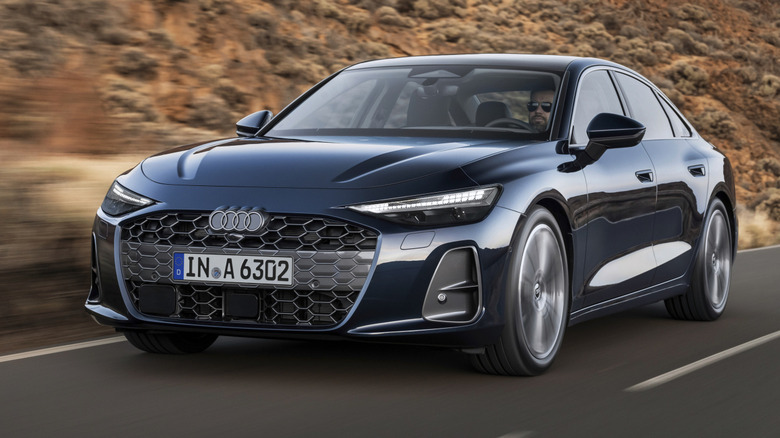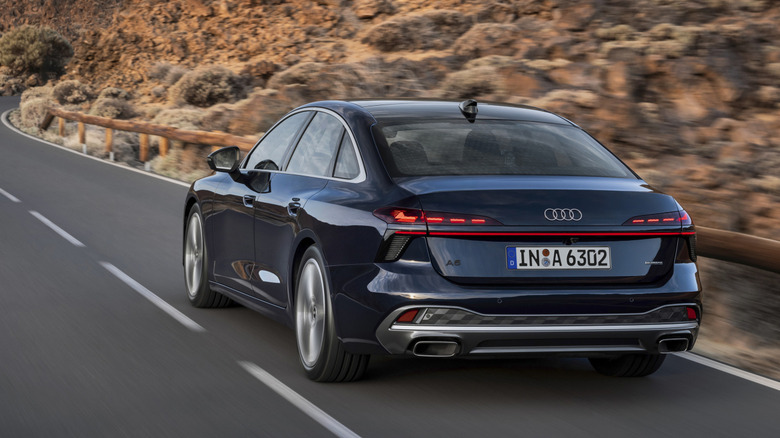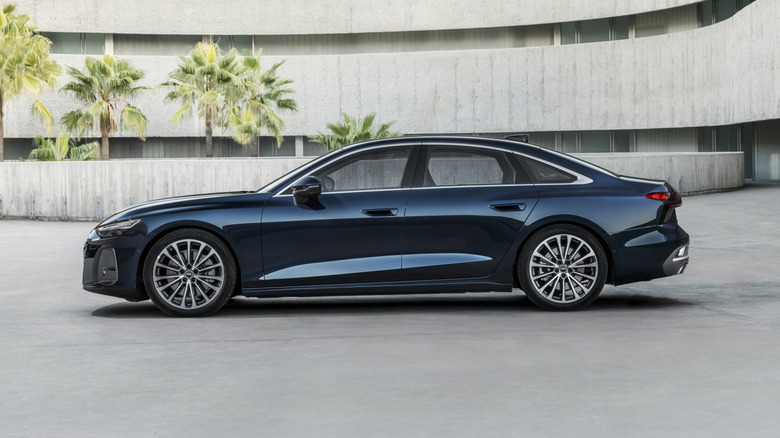Audi's New A6 Exposes A Big Problem Between The U.S. And The Rest Of The World
Audi has launched the newest iteration of the venerable A6 sedan for the 2026 model year, with several refinements and tweaks over the previous model. It claims to be one of the most aerodynamic gas-powered Audi's ever, and one of the quietest. In a press release, Audi said that every A6 with 19-inch or larger wheels gets fitted with noise absorbing materials inside the tire; pair that with a claimed 30% noise reduction and you have a serene business sedan.
The new sedan also brings a redesigned interior with a heads up display, 64-color ambient lighting, and of course, quite a bit of space, with a trunk capacity of 17.76 cubic feet.
The A6 also comes with three engine choices, a turbocharged 2.0-liter four-cylinder, a 2.0-liter turbo diesel option, and a 362 horsepower 3.0-liter turbocharged V6. Both 2.0-liter powertrains also benefit from a mild hybrid electrification system for a small boost to torque. But then here's the rub with the new A6. The model bound for the United States will only be available with the V6, and a number of other features are unavailable in the States. That's not entirely unusual for global car launches, but they're exclusions which be a sign of things to come for cars made overseas.
Changes for the U.S. market
Right at the beginning of its press release, Audi notes, in no uncertain terms "no MHEV (mild-hybrid electric vehicle) in U.S." Additionally, American A6 sedans won't get Audi's Kincade and Dinamica interior fabric choices. A6s bound for the States also won't get adaptive LED headlights. Americans still get the A6, to be sure, just most of it.
Audi didn't site a specific reason for the exclusions, noting only "U.S. regulations" — and we've seen how those can impact the automaker's fancier front and rear lights before now — but one could take a guess that the ongoing tariff situation isn't going to help matters.
While U.S. customers might feel the sting of lacking features on a new, expensive sedan like the 2026 A6, it makes sense from a business perspective for Audi. The automaker will wisely only debut new technological features on a cutting edge car that it believes there's a market for, and that includes an audience willing to pay the premium for such features.
If including them causes the car to get tariffed out of existence, even a huge market like the United States might seem less worthwhile chasing. It's unfortunate, to be sure, and much of the logic around tariffs seems mostly senseless, but it's an inevitable side effect of using global supply chains in a politically tumultuous world.
Political turmoil
As of now, the A6's European version is only marginally different from the American model, and changes from continent to continent are nothing new. However, provided the tariffs get worse (or don't slow down significantly), there's no telling what options or models entirely stay in Europe. That doesn't just affect Audi, either, which can count on the backing (and subsequent funding) of Volkswagen Group to absorb or displace import tariffs.
Rather than rework their range, smaller, or less well provisioned automakers could simply opt to axe models from import entirely, if they are no longer sufficiently profitable, leaving the U.S. automotive market even more isolated than it already is.
As with all political and manufacturing-related machinations by large companies, there are a lot of moving parts involved and finding different suppliers or tariff pauses could change things for the better. There is, unfortunately, not a lot a customer Stateside can do about it apart from contacting their local representatives. In the meantime, Audi says that the A6 is expected to go on sale this summer and the price will be announced closer to that point.


